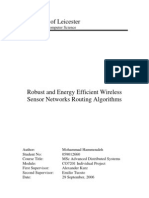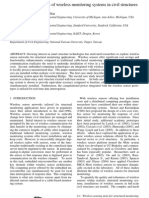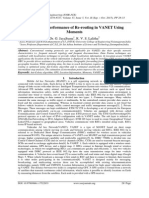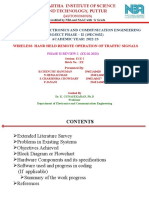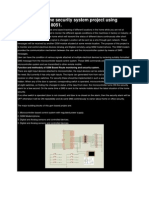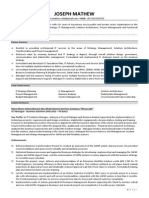Road Traffic Monitoring Using A Wireless Vehicle Sensor Network
Road Traffic Monitoring Using A Wireless Vehicle Sensor Network
Uploaded by
painkiller000Copyright:
Available Formats
Road Traffic Monitoring Using A Wireless Vehicle Sensor Network
Road Traffic Monitoring Using A Wireless Vehicle Sensor Network
Uploaded by
painkiller000Original Title
Copyright
Available Formats
Share this document
Did you find this document useful?
Is this content inappropriate?
Copyright:
Available Formats
Road Traffic Monitoring Using A Wireless Vehicle Sensor Network
Road Traffic Monitoring Using A Wireless Vehicle Sensor Network
Uploaded by
painkiller000Copyright:
Available Formats
2008 International Symposium on Intelligent Signal
Processing and Communication Systems (ISPACS2008)
SwissOtel Le Concorde,Bangkok,Thailand
Road traffic monitoring using a wireless vehicle
sensor network
Eng-Han Ng, Su-Lim Tan, Jesus Garcia Guzmant
School of Computer Engineering, Nanyang Technological University, Singapore 639798
t Facultad de Ingerieria Mecanica Electrica, Universidad Veracruzana, Xalapa, Mexico 91090
Abstract- With the advancement of Micro-Electro-
Mechanical Systems (MEMS) technologies, wireless sensor
networks have opened new vistas for a wide range of
application domains. These sensor nodes usually comprise small,
low-power devices that integrate sensors and actuators with
limited on-board processing and wireless communication
capabilities. One of the most important applications is target
tracking and monitoring. Here a novel wireless vehicle
monitoring system that is able to detect, classify and determine
the direction of travel of vehicles on a two-lane road is proposed.
Each vehicle detection node features multiple sensors including
magnetometer, accelerometer, infrared and acoustic
microphone with a two-node structure for cooperative
monitoring. The results show that the system was capable of
classifying the vehicle type (using vehicle weight) and their
directional of travel with high accuracy.
I. INTRODUCTION
A wireless sensor network is a network consisting of
spatially distributed autonomous devices. These devices use
sensors to cooperatively monitor physical or environmental
conditions such as temperature, sound and other parameters
at different locations [1] to enhance the system perfonnance.
This is made possible with the advancement in micro-
electro-mechanical systems (MEMS) technology, wireless
communications and digital electronics [2]. These
technologies have also enable the development of low cost,
low power, multifunctional and wireless sensor structures
that are small in size and able to communicate over short
distances.
The development of wireless sensor network was
initially motivated by military applications such as enemy
surveillance with DARPA [3] continuing to fund a number
of prominent research projects (e.g., Smart Dust, NEST) that
are commonly regarded as the cradle of sensor network
research. Such projects nonnally involve random
deployment of thousands of nodes covering large
geographical areas that are immobile and difficult to track
[1]. However wireless sensor networks are also making its
way into civilian application areas which includes habitat
monitoring [1], healthcare [4] and traffic control [1,4].
In one of the research project, wireless sensor nodes are
used to detect for vehicle berth occupancy in car parks [5].
The objective of the monitoring system was to provide real
time infonnation about the distribution of unoccupied
vehicle berth and to guide the drivers to empty parking lots.
A magnetometer is the only sensor used to detect for
vehicular presence in each hardware node. Due to the fact
that almost all road vehicles have significant amounts of
ferrous metals in their chassis (iron, steel, nickel, cobalt, etc.),
magnetometer is used to sense the corresponding magnetic
field disruption [6]. The magnetic sensor will be able to
978-1-4244-2565-5/08/$25.00 2008 IEEE
detect a change in the earth magnetic flux due to the
influence of the ferrous metals when a vehicle is in close
proximity. A vehicle will trigger either a berth occupied or
empty signal to the base station for processing. Cost savings
in system wiring is one of the main motivations for
implementing a wireless system.
In another research carried out at Ohio State University,
multiple sensors such as magnetometer and micro radar are
used for vehicular tracking. The project called "A Line in the
Sand" [7] consists of the deployment of 90 MICA motes for
co-operative tracking. The sensors are attached to the MICA
motes and used for tracking and classification of moving
objects with significant metallic content (specifically the
tracking of vehicles and anned soldiers). The motivation for
the research was to replace tripwires and enable the detection
of intrusion for a wider area of interest. Both of the above
mentioned application uses wireless sensor nodes to monitor
and/or track vehicles using specialized sensors. Due to the
fact that wireless sensor nodes are relatively cheap to
produce and deploy in numbers, they are used extensively in
monitoring applications to cover large geographical areas.
These advantages reshape how conventional monitoring
applications are carried out in the future.
With the use of wireless sensor network, multiple
sensory devices can be networked together to share
geographically distributed infonnation. This allows a cheap
and hassle-free deployment of a cooperative vehicle
monitoring system with more accurate results. An overview
of the monitoring system is shown in Fig. 1.
Fig. 1: Vehicle monitoring system setup
The system consists of two vehicle sensory nodes that
are placed on each side of a two-lane road. These nodes
feature four different types of passive detectors which
include magnetometer, accelerometer, infrared and acoustic
microphone to monitor the road conditions. These two
wireless sensory nodes will send the collected data to the
base node whenever a vehicle is detected. The consolidated
data will then be forwarded to a laptop or PDA where the
data can be analyzed to detennine the vehicle type (Light:
Motorcycles, Medium: Motorcars of weight not exceeding
2500kg, Heavy: Heavy motorcars of weight exceeding
2500kg) and direction of travel. This infonnation can then be
shown to the user through a simple graphical user-interface.
II. SYSTEM IMPLEMENTATION
The road traffic monitoring system consists of a 3-tier
structure. The system is made up of the end-node tier, base-
node tier and lastly the PC tier. The end-node tier is made up
of two vehicle sensor node each consisting of a Ziger SoC
board. The base-node tier consists of only one Ziger board
while the PC tier is connected to the base-node tier
physically with a USB seriallinlc
All data that is captured by the end-nodes will be
forwarded to the base node. The base node will then perfonn
pre-processing (if required) before forwarding the message
to the PC for analysis. Communication via the PC to the end-
nodes is also carried out through the services of the base
node using a star topology. The end-node tier is responsible
for vehicle detection and gathering all the data from its on-
board sensors. The end-node will also perfonn some data
pre-processing and only send the important infonnation to
the base tier. This will greatly reduced the wireless traffic
bandwidth requirements as opposed to sending the raw data
of each sensor. The base node will either broadcast the
message or sent a specific unicast packet to the end-node as
indicated by the command sent from the PC tier. Lastly the
PC will be focusing on interaction with the user and data
analysis of results gathered from the end-nodes.
Fig. 2: Vehicle sensors node
The prototype node has been designed and
implemented as shown in Fig. 2. Each unit is made up of a
Ziger SoC board and four sets of different sensors with
accompanying interfacing circuitry. The Ziger board features
a Freescale MC13213 MCU with embedded IEEE 802.15.4
RF wireless radio unit. The node is designed with an on-
board inverted-F antenna (default) with the options of
attaching an SMA whipped antenna if required. It also
includes a 64Mb Flash EEPROM for offline monitoring and
a USB interface with the host PC.
The sensors node features a 3-axis accelerometer used
for monitoring the seismic movements of a passing by
vehicle. The ACH-04-08-05 (MSI Sensor, USA) is able to
respond to over a wide range of frequency, from O.5Hz to
above 5KHz. This is ideal for low frequency vibration
sensing application such as vehicle-generated seismic
movements. A similar accelerometer was used in other
research project to differentiate vehicle types such as buses
and cars. The project was successful in classifying the type
of vehicles using neural network.
A 2-axis magnetometer (HMCI002, Honeywell, USA)
was used as the sensor to pick up changes to the earth's
magnetic flux caused by the passing vehicles. The
magnetometer is able to detect magnetic fields in the range
of 6 gauss which includes the earth's weak magnetic flux of
0.5 gauss. Thus a larger vehicle (assuming more ferrous
metals) will generate a corresponding bigger output by the
magnetometer.
A small condenser microphone was used as the acoustic
sensor to pick up the distinctive sound generated by the
passing vehicles. The sensor is able to pick up signals
ranging from 20Hz to 20KHz and has a sensitivity of -44dB.
The acoustic sensor was chosen due to its ability to pick up
engine noise which can be used as a signature to classify the
vehicle. Several research papers [8-9] have demonstrated the
feasibility of this process through signal processing and data
extraction using neural network. However the main
disadvantage of the acoustic sensor is that it will pick up
other surrounding sound such as wind and rainfall.
.
'" k:.lY;:,:: :l<_': 10;L;w '* .. :,,=-
: 10 17 Timf'(SKI
Hf'a\'yVehicle
Fig. 3: Vehicle sensors node outputs
The PIR sensor is used together with a Fresnel lens and
interfaced to an amplifying circuitry. PIR sensor was used to
detect the oncoming vehicles from a further range of 2--3m
as compared to the other sensors. This can be used for energy
saving features e.g. to turn on other near-field sensors only
when a vehicle approaches. The disadvantage of this sensor
is its inability to differentiate vehicles from other heated
objects like humans or animals. An example of the sensors'
outputs for "No vehicle", "Light vehicle" and "Heavy
vehicle" can be visualized in Fig. 3.
As seen from Fig. 3, the acoustic waveform is able to
detect oncoming vehicles earlier as opposed to near-field
sensors like the magnetic sensor and accelerometer. The
converse is also true in that it is the last sensor to return to
'rest' after the vehicle leaves the area of interest. Thus this
encapsulating effect of the acoustic sensor (over other
sensors) is used as a detection window for vehicle
monitoring in this project. It is only during this detection
window will the remaining sensors be monitored. The
recorded readings from other sensors will be used as validity
check after the window is terminated. This will allow the
end-node to identify false triggering by checking whether
each sensor is 'disturbed' during the window period. For
example a strong gust of wind can trigger an acoustic
detection window but the PIR sensor can be used to
invalidate the detection. Thus the co-operative use of
multiple sensors for verification can reduced the number of
false detection. Each end-node only makes use of four raw
signals namely PIR, acoustic, magnetic X-axis and
accelerometer Y-axis as opposed to the possible seven. This
is because the waveforms of both magnetic axes are very
similar and thus only one axis (X-axis) is selected for used.
Similarly one out of the three axis of the accelerometer is
used for monitoring. From Fig. 3, accelerometer output X
and Z axes can be observed to produce outputs that are less
significant in magnitude than axis Y. Thus this axis output
was selected to represent the accelerometer readings in the
application. In conclusion, the end-node will be collecting
the following data for transmission to the base node for each
valid detection window.
1. Start and End time of the acoustic signal detected
(thereby period can be calculated).
2. Number of peaks of the PIR sensor within the
window.
3. Minimum and Maximum value of the magnetic
sensor X-axis (thereby peak-to-peak amplitude can
be calculated) within the window.
4. Minimum and Maximum value of the accelerometer
sensor Y-axis (thereby peak-to-peak amplitude can
be calculated) within the window.
A valid detection window with the accompanying captured
data will be forwarded to the base node and subsequently to
the PC. The acquired data from the two sensors nodes will be
fed into a back propagation classifier to determine the type of
vehicle and direction of travel will be predicted.
III. METHODS
The system was setup along Nanyang Avenue at Nanyang
Technological University using 1 laptop and 3 wireless
nodes (2 for end-nodes and 1 for base node). The system
deployment can be seen in Fig. 4. The two end-nodes were
positioned on the curb of the road edge while the
accelerometer of each node was placed on the road side. This
placement of sensor nodes was chosen because it provides
the closest proximity with the vehicles without
compromising the safety of the nodes and vehicles.
The rational for this specific setup is to effectively
monitor both lanes of the road without loss of precision for
either lane. Initially both the end-nodes were placed on the
same side of the road to perform two-lane monitoring due to
ease of deployment. However test results showed that the
sensors reading for the further lane were relatively smaller in
magnitude. This is especially true for magnetic sensor as
readings drop significantly when the detection range
increases. This can be verified by the Honeywell magnetic
sensor application note which states that the sensor output
may drop to a tenth in magnitude if the detection range is
increased by one meter. This presents a problem to the
classifier as sensor readings of the farther lane were not very
representative and more classification error were resultant.
The adopted setup is able to monitor each lane of the road
and thus resolved the above mentioned problem. With this
approach, the end-node that is near the lane of travel will
pick up a stronger signal and thus will have more influencing
power during the classification process.
Fig. 4: Vehicle monitoring system deployment
IV. EXPERIMENTAL RESULTS AND DISCUSSION
RESULTS WITH TWO END-NODES SYSTEM
The system is deployed and tested during the day. Vehicles
traveling on the two-lane road were observed mostly to be of
medium type and of approximately 1.5 vehicles per minute
on both lanes of the road. The test was carried out to gather
50 vehicle readings which consist of heavy, medium and
light vehicles. The system output for the field test is
summarized as shown in Table 1.
The system is able to classify the vehicle type and
direction of travel with reasonably satisfactory accuracy as
shown in Table 1. It should be known that the accuracy of
the classification are tabulated based on the results of each
measured field e.g. Light vehicle, Right to Left Direction.
The neural network is able to achieve 100% classification
accuracy for medium vehicles as opposed to the other two
classes of vehicles. This may be because large portions of the
accumulated training data are of medium vehicles class as
the observed frequency of these vehicles are higher. With
more training data of medium vehicle class, the classifier is
able to build a more accurate classifier for such vehicle type.
Both the light and heavy vehicles are correctly classified to
an accuracy of 70-80% which was observed to vary from
their medium class counterpart.
Many heavy class vehicles are observed to be classified
into the medium class during the field test. This could be
because the sensor readings for both classes are not wide
varying enough. Most of the heavy vehicle training data and
test samples are of middle-sized lorries which are only
slightly bigger in size than conventional Multi-Personnel and
Sports-Utility Vehicles. However if double-decker buses or
other heavy-load vehicles such as dirt truck were included in
the training data and test, the classifier will be expected to
achieve more accurate results. Overall, the vehicle type
classifier is able to achieve 90% accuracy in detennining the
3 classes of vehicles. This high confidence level is partly
attributed by the medium type classification success.
Parameter
Actual S stem Outl ut
Accuracy
Events Light Med Heavy
Light 12 9 3 0 75.0%
Medium 26 0 26 0 100%
Heavy 12 0 2 10 83.3 %
9 31 10
Parameter
Actual System Output
Accuracy
Events Right to Left Left to Right
Direction
24 19 5 79.2tlo
rRight-Leftl
Direction
26 2 24 92.3tlo
[Left-Right]
21 29
Both parameters
50 39
correct 78%
Overall system accuracy (for both parameters)
System accuracy for classifying vehicles into their classes 90%
System accuracy for determining the direction of travel 86%
Overall system accuracy (for each parameter 88%
Table 1: Results of vehicle monitoring system
Directional analysis of the vehicle monitoring system
was also observed to perfonn satisfactorily. The classifier is
able to correctly identify vehicles traveling from right-to-Ieft
and vice-versa with 79% and 92% accuracy respectively.
Logically, the classifier will be able to co-relate the direction
of travel by identifying the sensor node with the higher
significant readings as the incoming direction. The classifier
should be able to utilize this trend to easily detennine the
direction of travel. However this method can only work with
the assumption that both sensor nodes are placed at a specific
distance apart. The system is able to achieve an overall
direction analysis of 86% with the current setup. Out of 50
vehicles that are detected in the field test setup, the system
was observed to correctly classify 39 vehicles into their
respective vehicle class and direction of travel. This 78%
system accuracy indicates the feasibility of the proposed
system for vehicle type and direction analysis. However
more work needs to be done to increase the classification
accuracy.
From the results of the experiment, the type of vehicle
and direction was detennined to be within 90% and 86%
accuracy respectively. The sensors used in the monitoring
node showed correlation to the type of vehicle detected.
However the differences between medium and light vehicles
are less obvious and this resulted in a lower classification
percentage for light vehicles. Nevertheless, the sensors were
able to identify the vehicle and reduce false triggering
through co-operative sensing.
Multiple sensor node system was also identified to
increases the detection accuracy as compared to single node
monitoring. Test results indicate that the use of two end-
nodes provides better classification results in both vehicle
type and directional analysis. The multiple sensor node
system saw a 22% increase in classification accuracy for
both parameters. However this assumption only holds for
single and 2 end-nodes system as verification of 3 and more
end-nodes system are not carried out.
A separate experiment to verify the positive correlation
of increase sensors with classification accuracy was also
carried out. The classification results show an improvement
of approximately 25% in correctly identifying both the type
and direction, as compared to the reduced sensor system.
Through this experiment, we are able to prove that the
combination of magnetometer and accelerometer perfonn
much better than using either of the sensors alone
v. SUMMARY
In this paper, we have devised a multiple nodes vehicle
sensing networked system using a diverse sensor array for
cooperative sensing. This system allows the software-based
classifier to achieve higher prediction accuracy while
reducing false triggering. The use of multiple sensors and
nodes has been demonstrated to produce results that are more
accurate through numerous experimental studies.
Nevertheless more tests need to be done to detennine the
optimal number of sensors (inclusion/removal of sensors)
and nodes to be used. Future work will focus on the effort to
detennine the positioning of each sensor node and how
different configurations can affect the overall system
accuracy. This will assist our understanding for potential
aerial based deployment where the nodes placements are
unstructured. The other interesting area is the use of sensor
array for knowledge discovery. Currently the data from the
four sensors are used only for vehicle-type classification and
travel direction analysis. The acquired sensors signals for
different vehicles can be further processed to extract other
features to provide more detailed infonnation about the
detected vehicle (e.g. speed of traveling). The system will
also be expanded for deployment on aT-junction or
crossroad junction to effectively monitor the traffic
movement. Such a system can eventually be used for
unmanned surveillance that can be deployed aerially.
REFERENCES
[1] T. Haenselmann, "Sensornetworks", http://www.informatik.uni-
mannheim.de/-haensel/sn book!, 5 April 2006.
[2] Q.S. Shan, Y. Liu, G. Prossec, D. Brown, "Wireless Intelligent Sensor
Networks for Refrigerated Vehicle", IEEE 6th CAS Symp on
Emerging Technologies: Mobile and Wireless Comm, Shanghai, China,
May 31-June 2, 2004.
[3] K. Romer, F. Mattern, "The Design Space of Wireless Sensor
Networks", IEEE Wireless Communications Vol: 11 Issue: 6, Dec,
2004.
[4] T.H. Arampatzis, J. Lygeros, S. Manesis, "A Survey of Applications of
Wireless Sensors and Wireless Sensor Networks, Intelligent Control",
Proceedings of the 2005 IEEE International Symposium on,
Mediterranean Conference on Control and Automation, 2005.
[5] Y. Wang, G.R. Zhou, T. Li, "Design of a Wireless Sensor Network for
Detecting Occupancy of Vehicle Berth in Car Park", Seventh
International Conference on Parallel and Distributed Computing,
Applications and Technologies (PDCAT'06), pp. 115-118,2006.
[6] Honeywell, "Vehicle Detection Using AMR Sensors", Application
Note-AN218, 2005.
[7] The Ohio State University, "A Line in the Sand",
http://www.cse.ohiostate.edu/siefast/nest/nest webpage/ALinelnTheSa
nd.html.
[8] M.L. Moran, D.G. Albert, "Source Location and Tracking Capability
ofa Small Seismic Array", U.S Army Corps of Engineers, 1996.
[9] H.D. Wu, M. Siegel, P. Khosla, "Vehicle Sound Signature Recognition
by Frequency Vector Principal Component Analysis", IEEE
Transactions on Instrumentation and Measurement Vol 48 No.5,
October 1999.
You might also like
- Scrapebox FootprintsDocument17 pagesScrapebox Footprintszachbrowne100% (2)
- Integrating IEC 61850 and DNPDocument10 pagesIntegrating IEC 61850 and DNPpainkiller000No ratings yet
- Low Cost AvDocument5 pagesLow Cost AvrahulsundaresanNo ratings yet
- 1.1 General A Transducer Is A Smart Device For Harvesting Energy of Street Light orDocument37 pages1.1 General A Transducer Is A Smart Device For Harvesting Energy of Street Light orRaja RKNo ratings yet
- Smart Dust The Mighty MiniatureDocument12 pagesSmart Dust The Mighty MiniatureRachita BiswasNo ratings yet
- A Parking Management System Based On Wireless Sensor NetworkDocument10 pagesA Parking Management System Based On Wireless Sensor NetworkKlarizze GanNo ratings yet
- WSN DocumentationDocument14 pagesWSN DocumentationRamzel Renz LotoNo ratings yet
- Automatic Bus Recognition Through Mobile: International Journal of Computer Trends and Technology-volume3Issue3 - 2012Document7 pagesAutomatic Bus Recognition Through Mobile: International Journal of Computer Trends and Technology-volume3Issue3 - 2012surendiran123No ratings yet
- Internet of Things Based Free Parking Space PDFDocument6 pagesInternet of Things Based Free Parking Space PDFDương NguyễnNo ratings yet
- Traffic Flow Management Using Wireless Sensor Networks: Project TitleDocument8 pagesTraffic Flow Management Using Wireless Sensor Networks: Project TitlevenkateshNo ratings yet
- BPI - Template - 2024 (2) (1111)Document16 pagesBPI - Template - 2024 (2) (1111)nitumoni0202No ratings yet
- Design of Wireless Sensor Network For Real-Time Structural Health MonitoringDocument4 pagesDesign of Wireless Sensor Network For Real-Time Structural Health MonitoringLamborighini-man GallardoNo ratings yet
- Simulation & Performance Study of Wireless Sensor Network (WSN) Using MATLABDocument8 pagesSimulation & Performance Study of Wireless Sensor Network (WSN) Using MATLABescanusNo ratings yet
- Robust and Energy Efficient Wireless Sensor Networks Routing AlgorithmsDocument73 pagesRobust and Energy Efficient Wireless Sensor Networks Routing Algorithms- -0% (1)
- Alacrity Control Using CateyeDocument5 pagesAlacrity Control Using CateyeRega RmsNo ratings yet
- Low Cost AvDocument5 pagesLow Cost Avdemondrifter777No ratings yet
- J. P. Lynch, K. J. Loh, T. C. Hou Y. Wang J. Yi, C. B. Yun K. C. Lu, C. H. LohDocument8 pagesJ. P. Lynch, K. J. Loh, T. C. Hou Y. Wang J. Yi, C. B. Yun K. C. Lu, C. H. LohMarlon Benson QuintoNo ratings yet
- The Sensors Networks WSN and VSN: A Theoretical ComparisonDocument8 pagesThe Sensors Networks WSN and VSN: A Theoretical ComparisonJohn BergNo ratings yet
- Smart Sensor Nodes For Airborne Particulate Concentration DetectionDocument10 pagesSmart Sensor Nodes For Airborne Particulate Concentration DetectionSergio MitmaNo ratings yet
- The Role of Current Technology in Street Light SystemDocument5 pagesThe Role of Current Technology in Street Light SystemNafiur Rahman100% (1)
- Gauging The Performance of Re-Routing in VANET Using MomentsDocument6 pagesGauging The Performance of Re-Routing in VANET Using MomentsIOSRjournalNo ratings yet
- IEEE Paper For Capstone Project PSAPDocument7 pagesIEEE Paper For Capstone Project PSAPSadamate IndrajeetNo ratings yet
- Data Collection Through Vehicular Sensor Networks by Using TCDGPDocument7 pagesData Collection Through Vehicular Sensor Networks by Using TCDGPRadhe KrishnNo ratings yet
- Implementing A Cooperative Mac Protocol For Wireless LansDocument8 pagesImplementing A Cooperative Mac Protocol For Wireless LansJournal of Computer ApplicationsNo ratings yet
- LORAWAN MainDocument18 pagesLORAWAN MainganeshrpujarNo ratings yet
- Iot NotesDocument24 pagesIot Notesperi cshodNo ratings yet
- Volume 1number 3PP 1103 1107Document5 pagesVolume 1number 3PP 1103 1107Kamal Ra JNo ratings yet
- Wireless Sensor NetworksDocument37 pagesWireless Sensor NetworksHemant MahajanNo ratings yet
- Ar2004-1107-1120 Domdouzis Anumba and ThorpeDocument11 pagesAr2004-1107-1120 Domdouzis Anumba and ThorpeUnknownNo ratings yet
- 1.1 Wireless Sensor Networks Wireless Sensor Networks (WSNS) Can Be Defined As A Self-Configured andDocument12 pages1.1 Wireless Sensor Networks Wireless Sensor Networks (WSNS) Can Be Defined As A Self-Configured andsowmiyaNo ratings yet
- Ubiquitous Networking Full ReportDocument24 pagesUbiquitous Networking Full ReportSurangma ParasharNo ratings yet
- Smart-Highways-Internet-of-Things: A Minor Project Report OnDocument7 pagesSmart-Highways-Internet-of-Things: A Minor Project Report Onvijay ratna prabhakarNo ratings yet
- Railway Track Crack Detection & Obstacle Detection SystemDocument4 pagesRailway Track Crack Detection & Obstacle Detection Systemraja maneNo ratings yet
- Railway Traffic ControlDocument4 pagesRailway Traffic ControlJournalNX - a Multidisciplinary Peer Reviewed JournalNo ratings yet
- An Intelligent Car Park Management System Based On Wireless Sensor NetworksDocument6 pagesAn Intelligent Car Park Management System Based On Wireless Sensor NetworksHema SaputraNo ratings yet
- Traffic Monitoring Using Multiple Cameras, Homographies and Multi-Hypothesis TrackingDocument4 pagesTraffic Monitoring Using Multiple Cameras, Homographies and Multi-Hypothesis TrackingImam FathurNo ratings yet
- On The Design and Implementation of Wireless Multimedia Sensor NetworksDocument7 pagesOn The Design and Implementation of Wireless Multimedia Sensor NetworksijngnNo ratings yet
- Automated Gas Leakage Detection SystemDocument3 pagesAutomated Gas Leakage Detection SystemManjunath ThamminidiNo ratings yet
- Vehicle-To-Vehicle and Road-Side Sensor Communication For Enhanced Road SafetyDocument12 pagesVehicle-To-Vehicle and Road-Side Sensor Communication For Enhanced Road SafetyManoj SharmaNo ratings yet
- adhoc practical fileDocument40 pagesadhoc practical filejaskaransingh1510No ratings yet
- 2024 Localization in Wireless Sensors NetworkDocument51 pages2024 Localization in Wireless Sensors NetworknithyadheviNo ratings yet
- Iot Unit-2Document10 pagesIot Unit-2MANGA SINDHUJA RGUKT BasarNo ratings yet
- Adhoc and Wireless Sensor NetworksDocument52 pagesAdhoc and Wireless Sensor Networkskumar27sahilNo ratings yet
- Density Based Traffic Light ControlDocument6 pagesDensity Based Traffic Light ControlVIVA-TECH IJRINo ratings yet
- Smart SubstationDocument116 pagesSmart SubstationLAXMI S FXEET036No ratings yet
- BharathDocument24 pagesBharathGeethaNo ratings yet
- Adhoc and Wireless Sensor Networks File LabDocument61 pagesAdhoc and Wireless Sensor Networks File LabV JNo ratings yet
- Ijece - Sewage Block Identification and Rescue System Using Wireless Sensor - 1Document6 pagesIjece - Sewage Block Identification and Rescue System Using Wireless Sensor - 1iaset123No ratings yet
- IOT Based Fire Detection System - Formatted PaperDocument7 pagesIOT Based Fire Detection System - Formatted PaperURK19CS1070 KEYURI YALLANo ratings yet
- SmartcarparkingsystemDocument7 pagesSmartcarparkingsystem21E135 MAHIESHWAR.JNo ratings yet
- Mine Fire Detection System Based Wireless Sensor: On NetworkDocument4 pagesMine Fire Detection System Based Wireless Sensor: On NetworkMohammad Al RshdanNo ratings yet
- Sensors: A Wireless Sensor System For Real-Time Monitoring and Fault Detection of Motor ArraysDocument5 pagesSensors: A Wireless Sensor System For Real-Time Monitoring and Fault Detection of Motor ArraysAbhijeet KeerNo ratings yet
- CPS & Chasis DynoDocument8 pagesCPS & Chasis Dynothomason mikeNo ratings yet
- An Innovative Method Using GPS Tracking, WINS Technologies For Border Security and Tracking of VehiclesDocument4 pagesAn Innovative Method Using GPS Tracking, WINS Technologies For Border Security and Tracking of VehiclesMithunMNo ratings yet
- Traffic Monitoring Using Iot: Santhiram Engineering College:NandyalDocument13 pagesTraffic Monitoring Using Iot: Santhiram Engineering College:Nandyalsangayashwanth205No ratings yet
- The Greatest Threat To National Security Is "Terrorism", Infiltrating Through BordersDocument12 pagesThe Greatest Threat To National Security Is "Terrorism", Infiltrating Through BordersJagadeesh ANo ratings yet
- Phase II Batch10Document22 pagesPhase II Batch10S SREENATHNo ratings yet
- Ijaerv14n2spl 04Document4 pagesIjaerv14n2spl 04srinivasNo ratings yet
- PIC Based Wireless Sensor NetworkDocument5 pagesPIC Based Wireless Sensor NetworkMustafa KhairallahNo ratings yet
- ICTISession 11-18Document8 pagesICTISession 11-18Tony TonyNo ratings yet
- IEC 61850 For Substation AutomationDocument39 pagesIEC 61850 For Substation Automationpainkiller000No ratings yet
- AC DC Railway Electrification and Protection PDFDocument43 pagesAC DC Railway Electrification and Protection PDFpainkiller000No ratings yet
- Ijireeice 59Document5 pagesIjireeice 59painkiller000No ratings yet
- A Design of Network-Based Flow Mobility Based On Proxy Mobile Ipv6Document6 pagesA Design of Network-Based Flow Mobility Based On Proxy Mobile Ipv6painkiller000No ratings yet
- Qos and Energy Efficient Resource Allocation in Downlink Ofdma SystemsDocument6 pagesQos and Energy Efficient Resource Allocation in Downlink Ofdma Systemspainkiller000No ratings yet
- Nonrigid Registration Using Free-Form Deformations: Hongchang Peng April 20thDocument28 pagesNonrigid Registration Using Free-Form Deformations: Hongchang Peng April 20thpainkiller000No ratings yet
- Alcatel-Lucent 4A0-101: Alcatel-Lucent Interior Routing Protocols and High AvailabilityDocument11 pagesAlcatel-Lucent 4A0-101: Alcatel-Lucent Interior Routing Protocols and High AvailabilityNayer Fatima KhanNo ratings yet
- CM WifiDocument21 pagesCM WifijemosqueraNo ratings yet
- CSC-103 Line Protection IED Product Guide (0SF.492.051E) - V1.10Document70 pagesCSC-103 Line Protection IED Product Guide (0SF.492.051E) - V1.10missle2007No ratings yet
- 6ES75111FK020AB0 - Datasheet - enDocument8 pages6ES75111FK020AB0 - Datasheet - enchochoroyNo ratings yet
- 5.2.1 Packet Tracer - Configure VTP and DTPDocument14 pages5.2.1 Packet Tracer - Configure VTP and DTPmarcelo tanimucaNo ratings yet
- Fundamentals of IOTDocument99 pagesFundamentals of IOTaaronjathannaNo ratings yet
- WEG Low Voltage Motor Control Center ccm03 50044030 Brochure English PDFDocument12 pagesWEG Low Voltage Motor Control Center ccm03 50044030 Brochure English PDFRitaban222No ratings yet
- Cloud Security Using Blowfish and Key Management Encryption AlgorithmDocument4 pagesCloud Security Using Blowfish and Key Management Encryption AlgorithmerpublicationNo ratings yet
- ITIL Service Support and Service DeliveryDocument2 pagesITIL Service Support and Service DeliveryhyrtksnNo ratings yet
- Installation and UpgradingDocument455 pagesInstallation and UpgradingSorya BareNo ratings yet
- Vendor Presentation-3 (Hardware Product Portfolio) - 0801Document61 pagesVendor Presentation-3 (Hardware Product Portfolio) - 0801btsupersuper100% (1)
- Make Social Media Work For Your BusinessDocument35 pagesMake Social Media Work For Your BusinessAndrew Richard Thompson100% (2)
- Analysis of Unsynchronization Carrier Frequency Offset For OFDM System Using Moose Estimation MethodDocument4 pagesAnalysis of Unsynchronization Carrier Frequency Offset For OFDM System Using Moose Estimation MethodIRJAESNo ratings yet
- GSM Based Home Security System Project Using Microcontroller 8051Document2 pagesGSM Based Home Security System Project Using Microcontroller 8051Debebe TsedekeNo ratings yet
- Call Center TerminologyDocument15 pagesCall Center TerminologyCalmguy ChaituNo ratings yet
- Resume Joseph Mathew IT ManagerDocument3 pagesResume Joseph Mathew IT ManagerjmathewdxbNo ratings yet
- Juniper Networks Netscreen 204 110004Document2 pagesJuniper Networks Netscreen 204 110004api-3775248No ratings yet
- Cisco IOS XE Hardening Guide - Last Updated 28 Feb 2023Document70 pagesCisco IOS XE Hardening Guide - Last Updated 28 Feb 2023prakash1649No ratings yet
- Design Guide - OpenShift 4.12 On Dell Intel InfrastructureDocument49 pagesDesign Guide - OpenShift 4.12 On Dell Intel InfrastructureWSNo ratings yet
- Lakshman Kundutrhi: Mobile No: +91-6300099218Document3 pagesLakshman Kundutrhi: Mobile No: +91-6300099218venkatNo ratings yet
- Centum VP 1B30 - 01Document314 pagesCentum VP 1B30 - 01atif010100% (3)
- Hacker Friendly Sbcs Spreadsheet 170101Document3 pagesHacker Friendly Sbcs Spreadsheet 170101Tomislav KostanjčarNo ratings yet
- SDN NotesDocument89 pagesSDN Noteshemapardeep8No ratings yet
- Distributed ComputingDocument11 pagesDistributed ComputingRahmat HidayatNo ratings yet
- Det Bill Excel ServletDocument14 pagesDet Bill Excel ServletHimali WickramasinghaNo ratings yet
- Implementation of Storage in Virtual Private Cloud Using Simple Storage Service On AWSDocument5 pagesImplementation of Storage in Virtual Private Cloud Using Simple Storage Service On AWSlemmesurvivehp03No ratings yet
- Call Center Scripts Call Sim Mock CallsDocument7 pagesCall Center Scripts Call Sim Mock Callsms.joycebalbin2023No ratings yet
- Rajasthan University of Health Sciences, Jaipur: Drug Control Officer Recruitment Examination 2012Document5 pagesRajasthan University of Health Sciences, Jaipur: Drug Control Officer Recruitment Examination 2012Sumit MidhaNo ratings yet
- DNSCDocument30 pagesDNSCfirdiaeNo ratings yet













